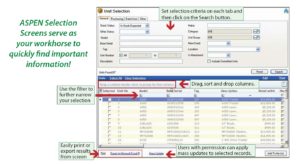Discover Your Data with ASPEN Selection Screens
ASPEN Selection Screens help you find the information you need when you want it. Selection Screens is a function within each component of the ASPEN dealership management system that enables you to quickly find important data by allowing you to search on virtually all fields of a record.
Selection Screens is a function within each component of the ASPEN dealership management system that enables you to quickly find important data by allowing you to search on virtually all fields of a record. Use the Selection Screens to easily create of list of items based upon a variety of criteria to use in other areas of the software.
For example, create a list of customers with aging invoices to use as a call list for your customer service reps, or a list of work orders that need to be closed to help get the wrenches turning in the shop. Your sales and parts staff will be able to quickly and easily find the items they are looking for, and accounting people will love the ease of finding entries in the system. Quickly locate information on customers, units, parts, work orders, journal entries, accounts payable vouchers, invoices and more.
ASPEN’s Selection Screens provide flexibility and ease of use that far exceeds any type of report that you can run on other business management systems:
- Search on virtually all fields of a record using any criteria you choose. For example, search for a Unit or Group of Units by stock status, model, make, description, dates which the unit was purchased/ordered/ received, date the unit record was created or modified, or across departments and or locations in the Units Selection Screen.
- Further refine and sort the resulting records from the search in an easy-to-view and sort grid, (as shown) where records can be grouped, sorted and filtered further.
- Records from search results are “drillable” to the original source record, eliminating a great deal time and effort otherwise spent searching through files or other records.
- Apply a mass update to the set of selected records (such as updating a parts price group) and save an enormous amount of time otherwise spent updating individual records.
- Customize and save layouts for later use.
- Create lists from the results and run them through basic reports for advanced reporting on subsets of data.
